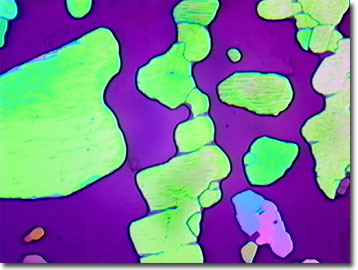Polarized Light Digital Image Gallery
Ethidium Bromide
Ethidium bromide, commonly employed in molecular biology laboratories, has been widely used for many years as a nucleic acid stain and a non-radioactive marker for identifying and visualizing nucleic acid bands in electrophoresis. A reddish-orange fluorescence can be detected under both long and short ultraviolet (UV) wavelengths of light, with increased fluorescence when bound to double-stranded DNA.

View a second image of ethidium bromide.
Known also as ethobromide, homidium bromide, and dromilac, ethidium bromide has a molecular weight of 394.31 and the rather complex chemical name of 3,8-diamino-5-ethyl-6-phenylphenanthridinium bromide. Appearing as dark red crystals when not in aqueous solution, ethidium bromide melts at approximately 239 degrees Celsius and is reportedly odorless. Ethidium bromide is a relatively large, flat basic molecule that somewhat resembles a DNA base pair. Because of its chemical structure, it can easily insert into a DNA strand, making it handy for experimental purposes, but dangerous to handle by the investigator.
As a well-studied DNA-specific fluorochrome, ethidium bromide is used with the Olympus WIG fluorescence filter cube and demonstrates a characteristic excitation wavelength of 545 nanometers and an emission wavelength of 605 nanometers. After binding to DNA, ethidium exhibits an increased fluorescence, and the DNA bands in the electrophoresis gels can be readily observed by examination under illumination by an ultraviolet lamp.
Although it is not regulated as a hazardous waste, the strong mutagenic and poisonous properties and possible carcinogenic and teratogenic characteristics of ethidium bromide should dictate its careful handling and disposal as a biohazard. Higher concentrations in electrophoretic gels are indicated when the color of the gel is dark pink or red, and such gels should be destained before disposal. The dust of ethidium bromide is very toxic by inhalation and is considered a severe respiratory irritant. If ethidium bromide solution or crystals contact skin, it will stain light to deep purple. An effective barrier to short-term exposure is created when lab gloves and other laboratory protective gear are made of nitrile. Newer fluorescent dyes have been developed for detecting nucleic acid components, which are much less toxic and risky than ethidium bromide, while featuring lower background fluorescence.
Contributing Authors
Omar Alvarado, Thomas J. Fellers and Michael W. Davidson - National High Magnetic Field Laboratory, 1800 East Paul Dirac Dr., The Florida State University, Tallahassee, Florida, 32310.
BACK TO THE POLARIZED LIGHT IMAGE GALLERY
BACK TO THE DIGITAL IMAGE GALLERIES
Questions or comments? Send us an email.
© 1995-2025 by Michael W. Davidson and The Florida State University. All Rights Reserved. No images, graphics, software, scripts, or applets may be reproduced or used in any manner without permission from the copyright holders. Use of this website means you agree to all of the Legal Terms and Conditions set forth by the owners.
This website is maintained by our
Graphics & Web Programming Team
in collaboration with Optical Microscopy at the
National High Magnetic Field Laboratory.
Last Modification Friday, Nov 13, 2015 at 01:19 PM
Access Count Since September 17, 2002: 9079
Visit the website of our partner in introductory microscopy education:
|
|
